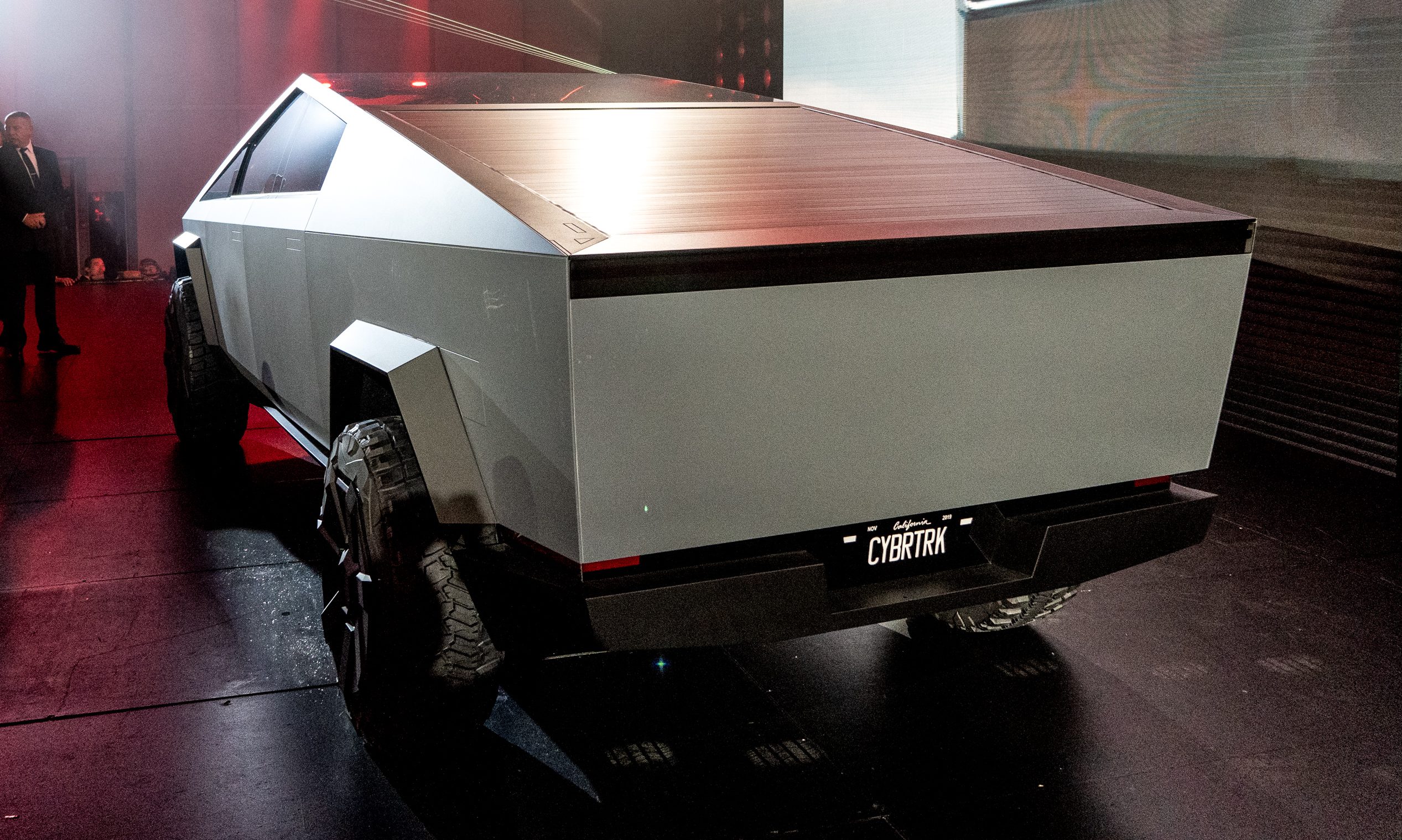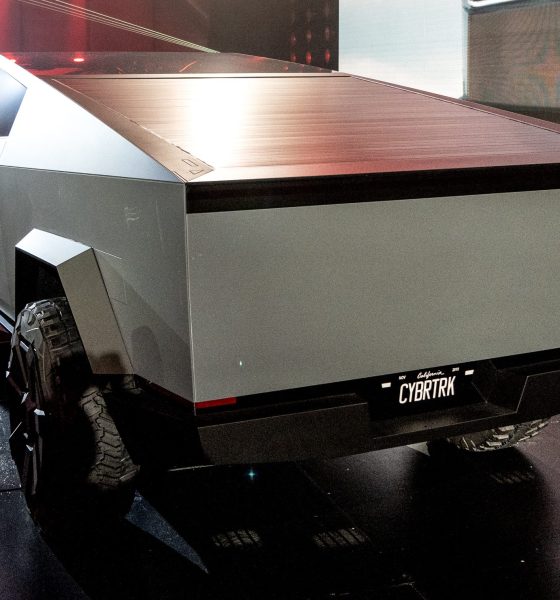

News
Tesla adds solar panels to Cybertruck for daily range boosts
Tesla’s Cybertruck may be as polarizing as Elon Musk previously suggested, but its combination of affordable price, killer specs, and crazy performance makes it a rather unusual-looking yet potentially formidable entry into the pickup truck segment. Yet, amidst all these capabilities, it appears that Tesla is also looking to make its pickup as the ultimate vehicle for camping and overlanding.
Images of the Cybertruck released online show that the vehicle will have an attachment that transforms the pickup into a camper, complete with a small kitchen and a table. Looking at the image shared by Tesla, it appears that the company has included as many features as it can into the Cybertruck, except the kitchen sink. Considering Elon Musk and Tesla’s tendency to adopt some humor in their creations, it would not be too farfetched if later iterations of the Cybertruck’s portable kitchen ends up getting an actual working sink.
Vehicles that engage in activities such as camping or Overlanding tend to stay in one location for several days. This means that if the Cybertruck were to be used for such purposes, the vehicle will likely remain parked in an outdoor location for extended periods. Tesla, if Elon Musk’s recent tweets are any indication, actually has a plan for this, with the CEO stating that the Cybertruck’s rear will have a Solar Powered tonneau cover, allowing the vehicle to recharge its batteries while it’s exposed to the sun.
The Tesla CEO provided some details on this design element in a response to a Tesla Model 3 owner on Twitter. In his response, Musk stated that Tesla will introduce an option to add solar power to the Cybertruck, allowing the massive pickup to generate about 15 miles of range per day on its own. Fold-out solar wings could also be added later, which would generate about 30-40 miles of range per day. This, according to Musk, actually covers the average miles per day traveled by drivers in the United States.
Musk’s recent tweets suggest that Tesla’s Cybertruck is a vehicle that has been a long time coming. By providing the Cybertruck with a way to generate power on its own (albeit in limited quantities), the addition of a built-in PV system into the pickup would enable the vehicle to gain more range as it stays parked in an outdoor spot. Such a system could even be useful for homeowners whose Cybertrucks will be parked at the driveway, where the vehicles will likely be exposed to the sun on a regular basis.
Elon Musk has stated multiple times in the past that the Tesla Cybertruck would be a polarizing vehicle that looks like it came out of the set of the Blade Runner franchise. Its design suggests that this was the case. That being said, the pickup is very impressive, with its ultra-hard stainless steel exoskeleton, Tesla Armor Glass, a 0-60 mph time of 2.9 seconds for its top trim, up to 500 miles of range per charge, and a premium, tri-motor AWD variant. Yet, for all its special features and unique look, the Cybertruck is very aggressively priced, with the base variant starting at a very reasonable $39,900.

News
Tesla FSD fleet is nearing 7 billion total miles, including 2.5 billion city miles
As can be seen on Tesla’s official FSD webpage, vehicles equipped with the system have now navigated over 6.99 billion miles.

Tesla’s Full Self-Driving (Supervised) fleet is closing in on almost 7 billion total miles driven, as per data posted by the company on its official FSD webpage.
These figures hint at the massive scale of data fueling Tesla’s rapid FSD improvements, which have been quite notable as of late.
FSD mileage milestones
As can be seen on Tesla’s official FSD webpage, vehicles equipped with the system have now navigated over 6.99 billion miles. Tesla owner and avid FSD tester Whole Mars Catalog also shared a screenshot indicating that from the nearly 7 billion miles traveled by the FSD fleet, more than 2.5 billion miles were driven inside cities.
City miles are particularly valuable for complex urban scenarios like unprotected turns, pedestrian interactions, and traffic lights. This is also the difference-maker for FSD, as only complex solutions, such as Waymo’s self-driving taxis, operate similarly on inner-city streets. And even then, incidents such as the San Francisco blackouts have proven challenging for sensor-rich vehicles like Waymos.
Tesla’s data edge
Tesla has a number of advantages in the autonomous vehicle sector, one of which is the size of its fleet and the number of vehicles training FSD on real-world roads. Tesla’s nearly 7 billion FSD miles then allow the company to roll out updates that make its vehicles behave like they are being driven by experienced drivers, even if they are operating on their own.
So notable are Tesla’s improvements to FSD that NVIDIA Director of Robotics Jim Fan, after experiencing FSD v14, noted that the system is the first AI that passes what he described as a “Physical Turing Test.”
“Despite knowing exactly how robot learning works, I still find it magical watching the steering wheel turn by itself. First it feels surreal, next it becomes routine. Then, like the smartphone, taking it away actively hurts. This is how humanity gets rewired and glued to god-like technologies,” Fan wrote in a post on X.
News
Tesla starts showing how FSD will change lives in Europe
Local officials tested the system on narrow country roads and were impressed by FSD’s smooth, human-like driving, with some calling the service a game-changer for everyday life in areas that are far from urban centers.

Tesla has launched Europe’s first public shuttle service using Full Self-Driving (Supervised) in the rural Eifelkreis Bitburg-Prüm region of Germany, demonstrating how the technology can restore independence and mobility for people who struggle with limited transport options.
Local officials tested the system on narrow country roads and were impressed by FSD’s smooth, human-like driving, with some calling the service a game-changer for everyday life in areas that are far from urban centers.
Officials see real impact on rural residents
Arzfeld Mayor Johannes Kuhl and District Administrator Andreas Kruppert personally tested the Tesla shuttle service. This allowed them to see just how well FSD navigated winding lanes and rural roads confidently. Kruppert said, “Autonomous driving sounds like science fiction to many, but we simply see here that it works totally well in rural regions too.” Kuhl, for his part, also noted that FSD “feels like a very experienced driver.”
The pilot complements the area’s “Citizen Bus” program, which provides on-demand rides for elderly residents who can no longer drive themselves. Tesla Europe shared a video of a demonstration of the service, highlighting how FSD gives people their freedom back, even in places where public transport is not as prevalent.
What the Ministry for Economic Affairs and Transport says
Rhineland-Palatinate’s Minister Daniela Schmitt supported the project, praising the collaboration that made this “first of its kind in Europe” possible. As per the ministry, the rural rollout for the service shows FSD’s potential beyond major cities, and it delivers tangible benefits like grocery runs, doctor visits, and social connections for isolated residents.
“Reliable and flexible mobility is especially vital in rural areas. With the launch of a shuttle service using self-driving vehicles (FSD supervised) by Tesla in the Eifelkreis Bitburg-Prüm, an innovative pilot project is now getting underway that complements local community bus services. It is the first project of its kind in Europe.
“The result is a real gain for rural mobility: greater accessibility, more flexibility and tangible benefits for everyday life. A strong signal for innovation, cooperation and future-oriented mobility beyond urban centers,” the ministry wrote in a LinkedIn post.
News
Tesla China quietly posts Robotaxi-related job listing
Tesla China is currently seeking a Low Voltage Electrical Engineer to work on circuit board design for the company’s autonomous vehicles.

Tesla has posted a new job listing in Shanghai explicitly tied to its Robotaxi program, fueling speculation that the company is preparing to launch its dedicated autonomous ride-hailing service in China.
As noted in the listing, Tesla China is currently seeking a Low Voltage Electrical Engineer to work on circuit board design for the company’s autonomous vehicles.
Robotaxi-specific role
The listing, which was shared on social media platform X by industry watcher @tslaming, suggested that Tesla China is looking to fill the role urgently. The job listing itself specifically mentions that the person hired for the role will be working on the Low Voltage Hardware team, which would design the circuit boards that would serve as the nervous system of the Robotaxi.
Key tasks for the role, as indicated in the job listing, include collaboration with PCB layout, firmware, mechanical, program management, and validation teams, among other responsibilities. The role is based in Shanghai.
China Robotaxi launch
China represents a massive potential market for robotaxis, with its dense urban centers and supportive policies in select cities. Tesla has limited permission to roll out FSD in the country, though despite this, its vehicles have been hailed as among the best in the market when it comes to autonomous features. So far, at least, it appears that China supports Tesla’s FSD and Robotaxi rollout.
This was hinted at in November, when Tesla brought the Cybercab to the 8th China International Import Expo (CIIE) in Shanghai, marking the first time that the autonomous two-seater was brought to the Asia-Pacific region. The vehicle, despite not having a release date in China, received a significant amount of interest among the event’s attendees.








